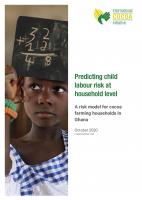In cocoa-growing areas of Côte d’Ivoire and Ghana, an estimated one in three children are in child labour. Most of these children work on family farms, alongside their relatives, doing activities that are considered “hazardous” under national legislation. While effective approaches exist to address child labour, their coverage remains limited compared to the overall need – effective approaches to protect children from hazardous work need to be scaled up to fill the gap. To achieve maximum impact with limited resources, it is essential that support is directed to the places where it is most needed, and that the people who need it most are prioritised for assistance. To do so, we need to be able to identify cocoa-farming households at the highest risk of using hazardous child labour.
This paper proposes a prediction model to identify cocoa farmers in Ghana who are at an elevated risk of using hazardous child labour, based on basic information about cocoa-producing households and their farms. Such information is commonly available in registers of cooperative members or certified producers in a supply chain; in some communities, local child protection committees maintain community registers, containing similar information.
